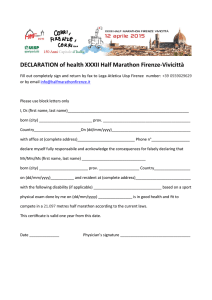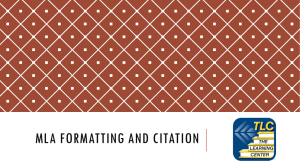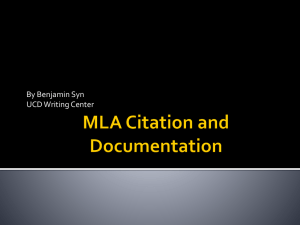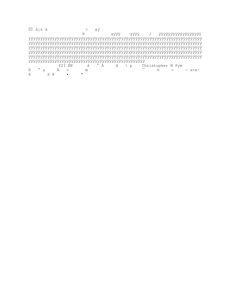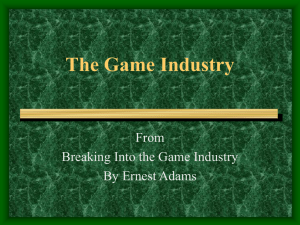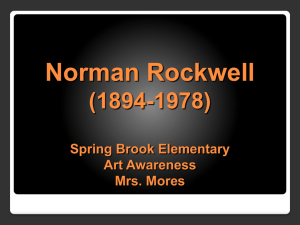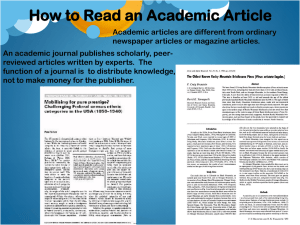How to Build a Works Cited Page
advertisement
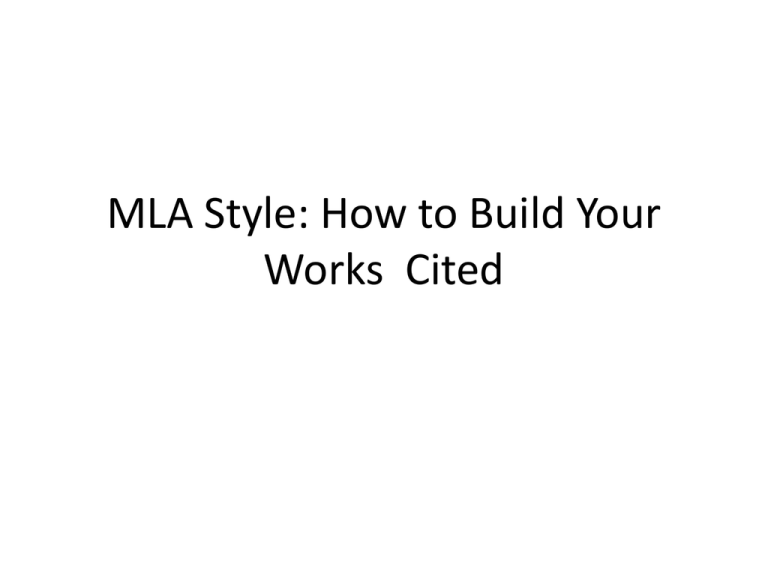
MLA Style: How to Build Your Works Cited What IS a Works Cited Section? “Works Cited” is MLA’s term for a list of references. If you’re as long in the tooth as I am, you will recall that this used to be called a paper’s “bibliography.” Today the word deemed too long for young moderns to grasp, and so we’ve reduced the title to words of one or two syllables. A “Works Cited” section is just a list of the sources you used in your paper. Nothing more, nothing less. What Goes into the Works Cited? • Full references to the sources (print, video, audio, and face-to-face interviews) you used in your paper • ONLY the sources you actually cited in your paper! • No dictionary references • Few or no encyclopedia references And the Big Deal IS…? Rigidity. Standard style manuals set out very precise models for authors to follow. These are annoying because each type of reference (e.g., book, video, journal article, magazine article) is considered a creature unto itself. The details and format of each reference vary according to the type of reference you’re using. Some of us consider this to be a manifestation of a vast interstellar plot to confuse students and writers. Conspiracy theories aside, the challenge is to figure out what kind of reference your source represents and document it accordingly. Crutches 1. The Big Source in the Cloud: Purdue’s Online Writing Lab (OWL) has a well organized and understandable section explaining and giving examples of MLA Style. Go to http://owl.english.purdue.edu/owl/resource/747/01/ to get started. 2. Citation generators: Noodle Tools is popular: http://www.noodletools.com/ Another is Son of Citation Machine: http://citationmachine.net/index2.php Remember, with citation generators, it’s garbage in, garbage out! If you enter incorrectly formatted or incomplete data, the thing will output incorrect citations. Know what MLA style is supposed to look like! Works Cited: General format In MLA style, “Works Cited” entries usually contain the following information, roughly in this order: Books: Author’s Last name, Author’s First Name. Title of Book: Italic, Caps and Lower Case. City: Name of Publisher: YYYY. Medium. The YYYY stands for the year of publication. If the city is widely known, only the city’s name is used; if it’s some obscure burg or more than one place has the same name, then add the state abbreviation. “Medium” may be Print, Web, DVD, CD, etc. Popular periodicals: Author’s Last name, Author’s First Name. “Title of Work: Caps and Lower Case.” Title of Periodical in Italic and Caps & Lower Case. Day Month Year: Inclusive pages. Medium. Scholarly periodicals: Author’s Last name, Author’s First Name. “Title of Work: Caps and Lower Case.” Title of Periodical Caps and Lower Case. Volume. Issue (YYYY): inclusive pages. Medium. General Format: Ditz We’ve seen that titles of books and periodicals appear in italic, like this. That rule also applies to movies, TV series, and whole websites: Pride and Prejudice U.S. News and World Report Star Wars House, M.D. Purdue Online Writing Lab Titles of shorter items, such as articles, short stories, poems, songs, single episodes of TV series, and individual web pages that make up part of a larger website appear inside quotation marks, “like this”: “Dimensions of Educational Transactions in a Videoconferencing Learning Environment” “The Yellow Wallpaper” “Ode on a Grecian Urn” “Folsom Prison Blues” “House’s Head” “MLA Sample Works Cited Page” General Format: Ditz Hanging indent occurs where the first line is flush left with the margin and the following lines are indented. Works Cited entries are listed in hanging indent. It looks like this: Author’s Last name, Author’s First Name. Title of Work: Caps and Lower Case. City: Name of Publisher: YYYY. Print. Never make a hanging indent by hitting “return” at the end the first line and “tab” at the beginning of each following line!!! This timewaster will create headaches for you that will NOT QUIT!!!!!!! Instead, place your cursor in the Works Cited entry. Then find the Format > Paragraph menu. Click the dropdown menu under “special” and select “hanging. This will convert your entry to hanging indent, in the process greatly simplifying your life. Book Format, Ditz Note that titles are always set in caps and lower-case! Also notice that the titles of books and periodicals always appear in italics. Author’s last and first names are separated by a comma. Periods go after author’s name, after the book title, after the date, and at the end. A colon appears after the place of publication, and a comma appears after the title. The entry is set in hanging indent style. Italic! Author’s Last name, Author’s First Name. Title of Work: Caps and Lower Case. City: Name of Publisher, YYYY. Print. Books: Refinements An article or selection in a collection is listed by the author of the selection’s name. If the collection (anthology) shows an editor’s name, that person’s name is included, too, in a different place, and the inclusive page numbers where the selection appeared are added near the end. Like this: Boxankle, Oliver. “The Key to the Pacific Coast Order of Flying Ground Squirrels.” Essays on Mnemonic Devices. Ed. Harvey M. Wallbanger. New York: Random House, 2012. Print. Books: Refinements A translation or edited work includes the translator or editor’s name, after the title: Foucault, Michel. Madness and Civilization: A History of Insanity in the Age of Reason. Trans. Richard Howard. New York: Vintage-Random House, 1988. Print. Bronte, Charlotte. Jane Eyre. Ed. Margaret Smith. Oxford: Oxford UP, 1998. Print. Scholarly Journals: General Format Unlike the format for a popular magazine or a newspaper, the entry for a scholarly journal includes the volume and the number in which the article appeared. The volume is the number of a set of issues (usually numbered annually; if this is a journal’s sixth year of publication, it’s publishing issues in volume 6). The number (sometimes called the issue) is the specific issue in a given volume (if a journal is published quarterly, it has 4 numbers in each volume). Thus: Author’s Last Name, First Name. "Title of Article." Title of Journal Volume.Issue (YYYY): inclusive pages. Medium. Scholarly Journal: Example Name. “Article Title: Article’s Subtitle.” Journal Title NN:n (YYYY): nnn-nn. Medium. Duvall, John N. "The (Super)Marketplace of Images: Television as Unmediated Mediation in DeLillo's White Noise." Arizona Quarterly 50.3 (1994): 127-53. Print. Scholarly Journal: Ditz Period after author’s name. Quotation marks around the article title; period after the article title inside quote marks. Duvall, John N. "The (Super)Marketplace of Images: Television as Unmediated Mediation in DeLillo's White Noise." Arizona Quarterly 50.3 (1994): 127-53. Print. Title of Journal in Italics; no punctuation; volume number; period; issue number; no punctuation; year in parentheses followed directly by a colon. Than a space followed by the inclusive pages; period. Medium; period. Magazine Article: General Format A reference to a magazine article typically looks like this: Author(s). "Title of Article." Title of Periodical Day Month Year: pages. Medium of publication. Magazine Article: Example Author’s Last Name, First Name. "Title of Article." Title of Periodical DD MM YY: inclusive pages. Medium. Or Author’s Last Name, First Name. "Title of Article." Title of Periodical MM YY: inclusive pages. Medium. Aikins, Matthieu. “Our Man in Kandahar.” The Atlantic Nov. 2011: 84-91. Print. Magazine Article: Ditz Period after author’s name; period after article, inside end-quote mark. Journal title in italic. Aikins, Matthieu. “Our Man in Kandahar.” The Atlantic Nov. 2011: 84-91. Print. Space but no punctuation after Journal title. Abbreviate month. Colon after year. Period after pages. And remember period after medium. Magazine Article, Date Ditz For an article in a weekly magazine, include the day of the week in the publication date, using DD MM YYYY style: Poniewozik, James. "TV Makes a Too-Close Call." Time 20 Nov. 2000: 70-71. Print. Newspaper Article: General Format Similar to a magazine article, except that newpapers have section, usually denoted by letters of the alphabet (section A, section B, etc.). This affects page numbers. Author’s Last Name, First Name. "Title of Article." Title of Periodical DD MM YYYY: SectionPage. Medium of publication. Newspaper Article: Example Author’s Last Name, First Name. "Title of Article." Title of Periodical DD MM YYYY: SectionPage. Medium of publication. Sulcas, Roslyn. “A Transcendent Artist, Now Tethered.” New York Times 3 Feb. 2012: C1. Print. Newspaper (or Magazine) Article: Online Newspapers and magazines do not usually clone their hard-copy format on their web pages. So, the article as it appears online will have no page numbers, and of course the citation will give none: Sulcas, Roslyn. “A Transcendent Artist, Now Tethered.” New York Times 3 Feb. 2012. Web. Entire Website, General Format Author or Editor (if given; last name first). Name of Site. Version number (if available). Name of sponsoring institution or publisher, date created or published (DD MM YYYY, as available). Medium. Date accessed. Entire Website: Example Author or Editor (if given; last name first). Name of Site. Version number (if available). Name of sponsoring institution or publisher, date created, last updated, or published (DD MM YYYY, as available). Medium. Date accessed. Paradise Valley Community College. Maricopa County Community College District. 31 Jan. 2012. Web. 3 Feb. 2012. Note that no author or version number is given, so we just leave those out. Also, note that MLA no longer requires a URL. You may include one if your instructor or publisher asks for URLs, or if you simply want to have it for your own reference. A Page in a Website Author or Editor (if given; last name first). “Title of Page.” Name of Site. Version number (if available). Name of sponsoring institution or publisher, date created, last updated, or published (DD MM YYYY, as available). Medium. Date accessed. Webpage: Example Author or Editor (if given; last name first). “Title of Page.” Name of Site. Version number (if available). Name of sponsoring institution or publisher, date created, last updated, or published (DD MM YYYY, as available). Medium. Date accessed. “Office of Financial Aid.” Paradise Valley Community College. Maricopa County Community College District. N.d. Web. 3 Feb. 2012. Abbreviations Months are abbreviated with three letters: Jan. Mar. Sep. May, obviously, is spelled out. N.d.: No date given N.p.: No place given N. pub.: No publisher given How to Alphabetize Your Works Cited Remember how I told you NOT to making hanging indents with hard returns and tabs? Well, here’s one reason. Assuming you haven’t done that, with MS Word you can alphabetize the entries you’ve typed for your Works Cited by highlighting them all and than going to Table > Sort. Click on “Sort” Word will rearrange all your entries alphabetically. BUT… Word sees each hard return (every place where you’ve pressed the “Enter” or “Return” key) as the end of an entry. So you must be sure there are no stray hard returns anywhere in your list. If you’ve gone “Return/Tab Return/Tab Return/Tab” to format your hanging indent, Word will alphabetize every single line, and that will be ridiculous. Remember: in case of screw-up, CTRL-Z to undo! Alphabetizing Your Works Cited should be alphabetized by the authors’ last names. If an entry has no author, alphabetize it by the first real word in the title (not “a,” “an,” or “the”—these words are called “articles”). If you’re using Word’s “sort” function, note that Word sees an open-quote mark as a character and so will gather all authorless entries that start with titles in quotation marks together at the beginning of the list. So, the easy way around this is first to delete all initial articles and all open-quotes that occur before an entry’s first word; then to run “Sort”; and then to go back in and re-enter the stuff you deleted. Get Thee to Purdue This has gone on altogether too long. There are many permutations of these basic styles. When in doubt, LOOK IT UP! http://owl.english.purdue.edu/owl/section/2/11 /
